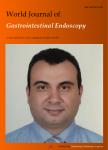Deep sedation for endoscopic retrograde cholangiopacreatography
Deep sedation for endoscopic retrograde cholangiopacreatography作者机构:Departments of Anesthesiology Benizelion General Hospital Heraklion Crete 71409 Greece Departments of Gastroenterology Benizelion General Hospital Heraklion Crete 71409 Greece
出 版 物:《World Journal of Gastrointestinal Endoscopy》 (世界胃肠内镜杂志(英文版)(电子版))
年 卷 期:2011年第3卷第2期
页 面:34-39页
学科分类:1002[医学-临床医学] 10[医学] 100217[医学-麻醉学]
主 题:Deep sedation Endoscopic retrograde cholangiop acreatography Monitoring Sedatives
摘 要:Sedation and analgesia comprise an important element of unpleasant and often prolonged endoscopic retrograde cholangiopacreatography (ERCP), contributing, however, to better patient tolerance and compliance and to the reduction of injuries during the procedure due to inappropriate co-operation. Although most of the studies used a moderate level of sedation, the literature has revealed the superiority of deep sedation and general anesthesia in performing ERCP. The anes- the siol ogist s presence is mandatory in these cases. A mod erate sedation level for ERCP seems to be adeq uate for octogenarians. The sedative agent of choice for sedation in ERCP seems to be propofol due to its fast distribution and fast elimination time without a cumulative effect after infusion, resulting in shorter recovery time. Its therapeutic spectrum, however, is much narrower and therefore careful monitoring is much more de manding in order to differentiate between moder ate, deep sedation and general anesthesia. Apart from conventional monitoring, capnography and Bispectral index or Narcot rend monitoring of the level of sedation seem to be useful in titrating sedatives in ERCP.



